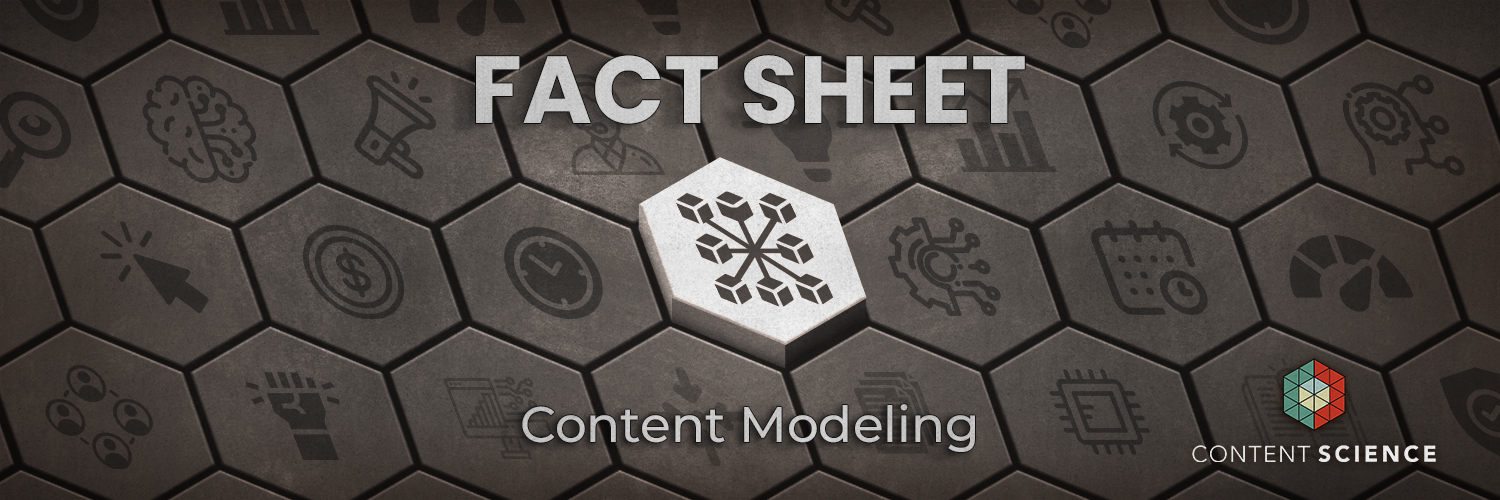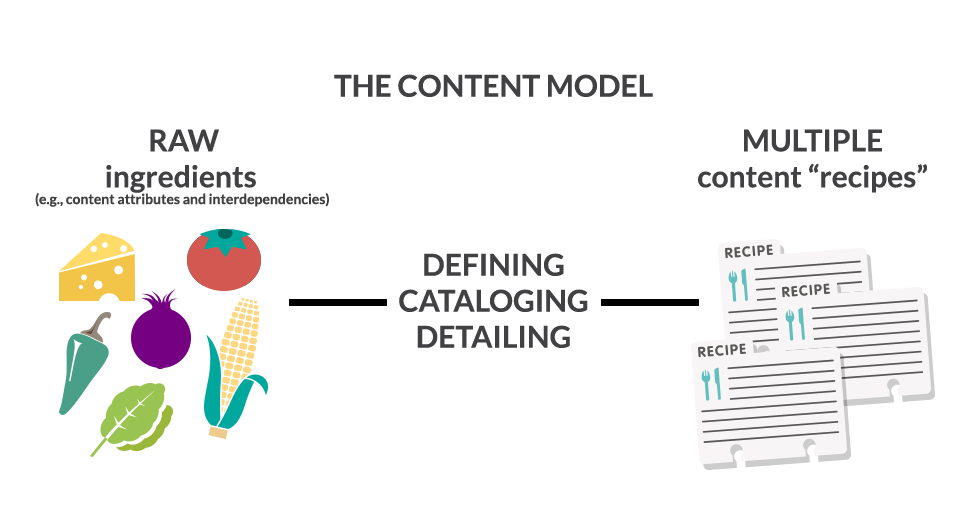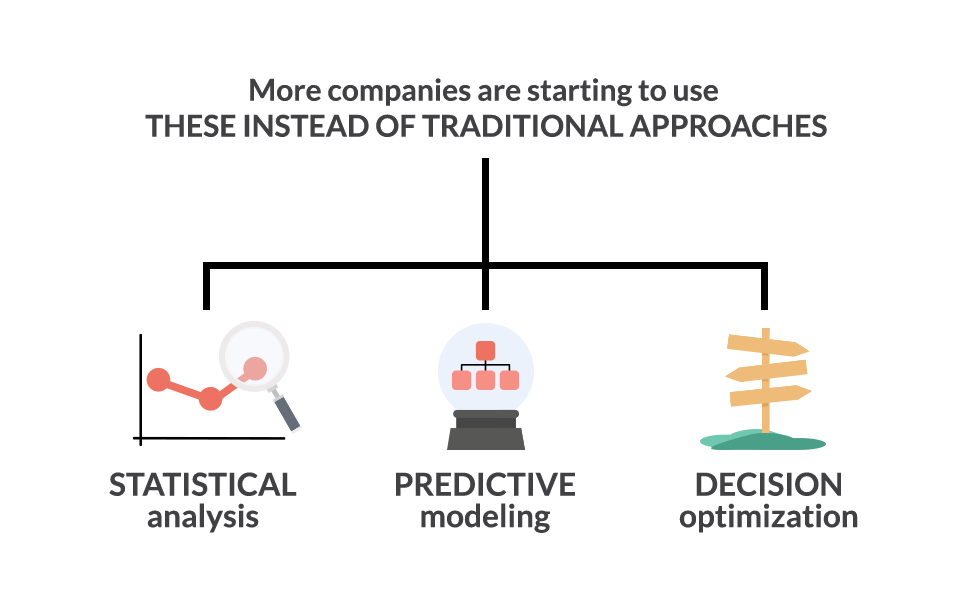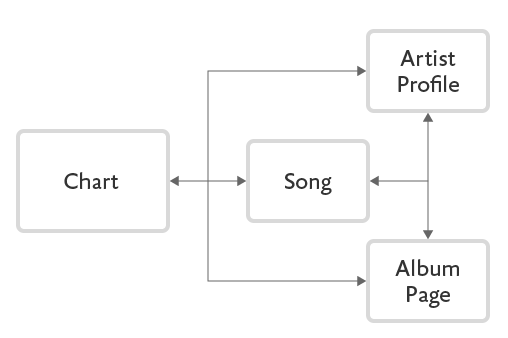
To begin, let’s identify some of the important elements of content modeling:
In layman’s terms, the content model is a way of defining and cataloging raw ingredients (e.g., content attributes and interdependencies) and detailing how those ingredients combine into multiple content “recipes.” Because content modeling can be tackled in small, manageable increments, it’s an excellent introductory activity for an organization overwhelmed by a large volume of unstructured, uncategorized content. — Getting Started with Structured Content
 However, this complex topic deserves further definition and clarification. Consider these elements of content modeling:
However, this complex topic deserves further definition and clarification. Consider these elements of content modeling:
Content modeling requires you to simultaneously understand your goals at the highest level and get intimate with your content’s most minute attributes, and there’s a pretty big chasm in between. Luckily, there’s an entire discipline dedicated to bridging that divide: content strategy. — Republic of Quality
Content modeling is a critical portion of the implementation. In this phase, you identify your organization’s requirements, develop a taxonomy (classification system) that meets those requirements, and consider where metadata should be allowed or required. CAUTION: Do not overlook the importance of metadata. — ContentStrategy101
In short, a content model gives structure and organization to your content. Within your overall content model, you’ll have individual content types. You can think of each content type as an outline for your content; it tells you what data will be contained within each individual entry. You can also think of the content type as the “stencil” for the “drawing” that will be your entry. — Contentful
A content model documents all the different types of content you will have for a given project. It contains detailed definitions of each content type’s elements and their relationships to each other. You can capture a high-level version in an org chart-style diagram, or use a spreadsheet to capture a more detailed version. The level of detail in the model is determined by the purposes you need it to serve. — A List Apart
A simple, high-level content model
So why does your organization need to embrace content modeling and digital transformation? Gartner explains, “Today, with fewer regulated monopolies and the internet eliminating geographical boundaries, more companies are starting to use statistical analysis, predictive modeling, and decision optimization to compete, instead of using traditional approaches.”
 One of the prominent ways content modeling has emerged is through the focus on mapping user journeys. As Content Science CEO Colleen Jones explains, “Defining user journeys is a big effort that takes time and resources, so you’ll probably want to ensure the result doesn’t, well, suck.” These user journey models are important tools for many reasons, and McKinsey & Company shares a few keys related to defining your user journeys: “Our research has found that journey performance is significantly more strongly linked to economic outcomes than are touchpoints alone. Modeling customer satisfaction around journeys rather than touchpoints enables you to estimate the most important end-to-end journeys across customer segments.”
One of the prominent ways content modeling has emerged is through the focus on mapping user journeys. As Content Science CEO Colleen Jones explains, “Defining user journeys is a big effort that takes time and resources, so you’ll probably want to ensure the result doesn’t, well, suck.” These user journey models are important tools for many reasons, and McKinsey & Company shares a few keys related to defining your user journeys: “Our research has found that journey performance is significantly more strongly linked to economic outcomes than are touchpoints alone. Modeling customer satisfaction around journeys rather than touchpoints enables you to estimate the most important end-to-end journeys across customer segments.”
 To utilize content modeling to reach your business goals, consider these three ways of creating content models as explained by Rachel Lovinger:
To utilize content modeling to reach your business goals, consider these three ways of creating content models as explained by Rachel Lovinger:
The assembly model: The way content creators will put individual content items together to make webpages, campaigns, documents, or other content products.
The content types: The various configurations of content that are distinct enough to be unique types in the system.
The content attributes: The content and metadata elements that make up each type, including how they relate to each other.
In addition to thinking through creating content models, Cognifide’s CTO encourages organizations to think about the lifecycles of content models and the need to continually refine. Gibbon identifies the three important stages in their lifecycle as:
Conceptual: The initial content model that aims to capture the names and high level relationships between content types.
Design: Adds more detail in the form of attributes to each content type and further refines the structural relationships between them.
Implementation: Models the content within the context of the target technology, e.g., CMS, Search Engines, Semantic Tools, etc.
He adds, “Each content model talks volumes to the right target audience. One size does not fit all. Instead, we have to start small, stand on a few key successes, and move forward.” One key is content engineering behind the scenes, which involves activities like these:
- Modeling content structures, schemas, and semantics
- Architecting content using taxonomies and other metadata magic
Intelligent content is structuring content, especially modeling it with metadata, to optimize its performance with technology and, in turn, create better experiences for customers and more efficient content management for businesses. — What is Content Intelligence?
Keep in mind that “content engineering produces impressive results. By streamlining content entry, improving taxonomy management, and refining delivery models, content engineering helped Nikon USA’s Learn and Explore content marketing platform to provide a 48% increase in article views and a 101% increase in visits that ended with customers adding a Nikon product to their carts,” explains Kanban, a marketing technology consultancy and integrator specializing in content, commerce, and experience management.

Events, Resources, + More
The Ultimate Guide to End-to-End Content
Discover why + how an end-to-end approach is critical in the age of AI with this comprehensive white paper.
The Content Advantage Book
The much-anticipated third edition of the highly rated book by Colleen Jones is available at book retailers worldwide. Learn more!
20 Signs of a Content Problem in a High-Stakes Initiative
Use this white paper to diagnose the problem so you can achieve the right solution faster.
Upskill with Content Science Academy
Training for modern content roles through on-demand certifications + courses or live workshops.







Comments
We invite you to share your perspective in a constructive way. To comment, please sign in or register. Our moderating team will review all comments and may edit them for clarity. Our team also may delete comments that are off-topic or disrespectful. All postings become the property of
Content Science Review.